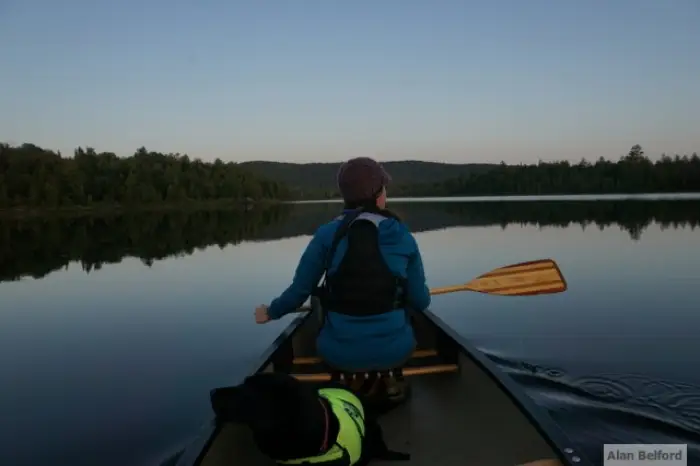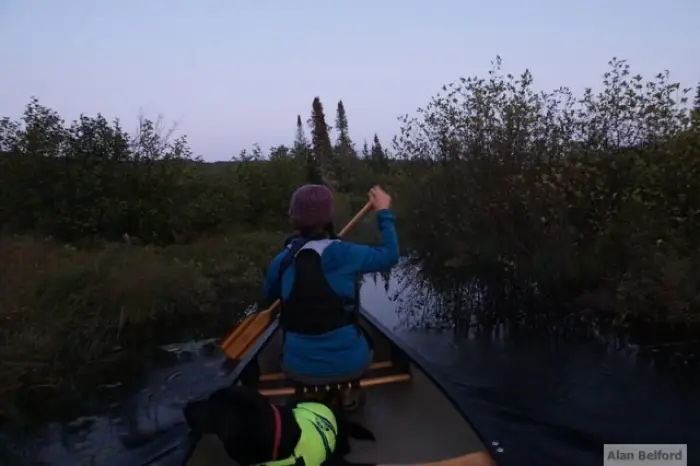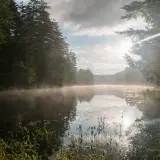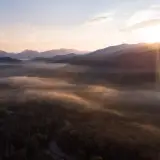Setting up Camp
My friend and I were doing some exploring east of Long Lake, having made quick stops in places like the canoe access for Fishing Brook (between Long Lake and Newcomb), and finding Red Crossbills along the way – our first of several for the trip. We decided to set up camp in Vanderwhacker Wild Forest off Moose Pond Way, the road which takes hikers to the trailhead for Vanderwhacker Mountain.
Paddling Cheney Pond
Our tents up and with an evening of light still left in the day, we bumped back down the rocky and rough road and drove a short distance to check out Cheney Pond, a place where I’ve birded but never paddled in the past. We snacked on the way as part of our dinner – it is all too easy when adventuring to push meals off until late!

Cheney is a picturesque little pond located off of Blue Ridge Road before the road descends to the Northway, and we quickly unloaded in the soft blue light of late day to maximize our time on it. A few Cedar Waxwings fed from the tops of the trees along the edge of the water, and a pair of Common Loons sat out in the middle of the pond, their shapes mirrored by the glassy surface. We began our loop of the pond’s jagged outline, chasing a Belted Kingfisher ahead of us, which chattered as it flew low over the water from perch to perch.
The local beaver was less easily intimidated by our quiet paddling and it slid alongside us, slapping its tail in disapproval of our audacity to trespass on its lake. Beavers are always good for such shenanigans, and I chuckled while Wren jerked her head up in alarm with each slap – it’s a consistent part of our evening paddles.

Portions of the pond’s boundary are characterized by boggy and marshy habitat, and we poked around to see what else we could find, chasing up a Great Blue Heron and pausing to admire the tufts of cotton grass which accented the green vegetation. In this way we eventually wound our way to the backside of the pond where a small, snaking stream connects it with the Boreas River, as the river runs along the border of the Hoffman Notch Wilderness Area. From there, paddlers can travel a couple more miles along Lester Flow.

We didn’t have enough daylight for such a venture, and the tiny waterway is blocked by a muddy beaver dam, so we chose not to carry past the dam the short distance to put-in on the Boreas. But the brushy habitat of alders along the waterway held a group of chattering birds – White-throated, Song, and Swamp sparrows, Common Yellowthroats, and a Least Flycatcher or two – who, like the beaver, thought we didn’t belong there at that point in the evening — chipping loudly at our approach. We turned around to paddle the waterway back to Cheney, and then continued to loop the rest of the pond’s outline, spotting a few bats scooping up insects over our heads.
A Beautiful Night and Morning in Camp
Once back and loaded at the car, we drove the darkening road back to our camp, where we enjoyed a late dinner and a star-filled sky before heading to bed. A brief rain storm ushered in the following morning and I had to wake long enough to zip up the door to my tent to keep the spray off me and Wren. But the rain was short-lived, and as dawn approached I heard the nocturnal flight calls of a few migrants overhead as I debated if I wanted to rouse my tired body.

Eventually I was up, and we puttered bleary-eyed around camp listening to still more flight calls – these were the daytime calls of Red Crossbills overhead. Thanks to an excellent crop of cones on our conifers across the Adirondacks, crossbills have been in many places in the region this summer. I heard them a few more times during the morning and we later heard White-winged Crossbills as well.
Looking to spot the crossbills, I watched clouds racing each other across the sky, revealing patches of blue as the front pushed through the area. Even with the wind in the trees we could hear Black-capped Chickadees, Golden-crowned Kinglets, and Red-breasted Nuthatches calling from the forest surrounding our camp, and I "spished" to see if there were vireos or warblers mixed in with them. A short time later, a Black-backed Woodpecker called from the nearby conifers. The constant distraction meant that breakfast and packing up wet tents may have taken longer than it would have otherwise, but we were outside to explore and there is little to complain about being able to explore directly in camp. But in the end we were fed and packed, and we headed out to continue our exploration of the beautiful fall-like day.
Late summer and fall offer great opportunities for outdoor adventure. Plan your trip today by checking out our lodging and dining pages.




